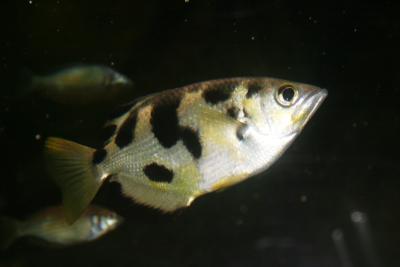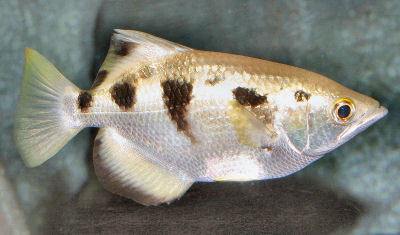
Toxotes jaculatrix
FAMILY
Toxotidae
TAXONOMY
Toxotes jaculatrix Pallas, 1767, Indian Ocean.
OTHER COMMON NAMES
None known.
PHYSICAL CHARACTERISTICS
Body is compressed and almost triangular, with a pointed head.
Color is silvery white with five black bands across the upper
sides of the body, the dorsal fin, and the caudal peduncle, and
yellow on anal, caudal, and dorsal fins. These fishes grow to 8
in (20 cm) total length.
DISTRIBUTION
Widespread from India and Sri Lanka, east through Southeast
Asia, the Ryukyu Islands, Palau and Yap in Micronesia,
Melanesia, and parts of Queensland in northern Australia; also
in Vanuatu.
HABITAT
Generally found in bays, estuaries, and the lower reaches of
rivers and creeks, usually among mangrove branches and roots.
BEHAVIOR
Occurs singly or in small groups around shelter. Swims slowly as
it hunts for prey both below and above the surface of the water.
Will swim rapidly on occasion to challenge conspecifics. As with
other archerfishes, the banded archerfish will hunt by shooting a
stream of water drops at terrestrial prey above the surface.
REPRODUCTIVE BIOLOGY
Gonochoristic, with pair spawning and the release of demersal
eggs near the bottom. Others in the genus release either
pelagic or demersal eggs. Demersal eggs are larger compared
to pelagic eggs in this species, about 0.023–0.031 in (0.6–0.8
mm) in diameter. Larvae hatch at 0.12 in (3 mm) in length, are
pelagic, possess a large yolk sac, have an unformed mouth, and
lack pigmented eyes. With growth, the body becomes moderate
in depth and the mouth large. Possesses a gas bladder. The
development of head spines is regarded as a specialization for
pelagic life.
CONSERVATION STATUS
Not listed by the IUCN.
SIGNIFICANCE TO HUMANS
Taken in subsistence fisheries and as a light-tackle gamefish,
but more importantly as an aquarium fish.
Photo Gallery of - Banded archerfish





 Animalia Life
Animalia Life